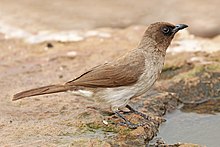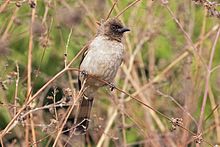Common bulbul
| Common bulbul | |
|---|---|

| |
| P. b. barbatus, Morocco | |

| |
| P. b. inornatus, Bukau Forest, Gambia | |
| Scientific classification | |
| Domain: | Eukaryota |
| Kingdom: | Animalia |
| Phylum: | Chordata |
| Class: | Aves |
| Order: | Passeriformes |
| Family: | Pycnonotidae |
| Genus: | Pycnonotus |
| Species: | P. barbatus
|
| Binomial name | |
| Pycnonotus barbatus (Desfontaines, 1789)
| |
| Synonyms | |
| |
The common bulbul (Pycnonotus barbatus) is a member of the bulbul family of passerine birds. It is found in north-eastern, northern, western and central Africa.
Taxonomy and systematics[edit]
The common bulbul was originally described in the genus Turdus. Some authorities treat the Somali, Dodson's and dark-capped bulbul as subspecies of the common bulbul.[2] The common bulbul is considered to belong to a superspecies along with the Himalayan bulbul, white-eared bulbul, white-spectacled bulbul, African red-eyed bulbul, and the Cape bulbul.[3] Alternate names for the common bulbul include the black-eyed bulbul, brown bulbul (also used for the Asian red-eyed bulbul), brown-capped geelgat, common garden bulbul, garden bulbul and white-vented bulbul as well as one name used for another species (yellow-vented bulbul).
Subspecies[edit]
Five subspecies are recognized:[4]
- P. b. barbatus (Desfontaines, 1789) — Alternate names for the nominate race include Barbary bulbul and North-west African garden bulbul. Found from Morocco to Tunisia
- Upper Guinea bulbul P. b. inornatus (Fraser, 1843) — Originally described as a separate species in the genus Ixos. Found from southern Mauritania and Senegal to western Chad and northern Cameroon
- Gabon bulbul P. b. gabonensis Sharpe, 1871 — Originally described as a separate species. Found from central Nigeria and central Cameroon to Gabon and southern Congo
- Egyptian bulbul P. b. arsinoe (Lichtenstein, MHK, 1823) — Originally described as a separate species in the genus Turdus. Alternately named the Sahel garden bulbul. Found in eastern Chad, northern and central Sudan and eastern Egypt
- Abyssinian bulbul P. b. schoanus Neumann, 1905 — Not to be confused with an alternate name for the Somali bulbul. Found in south-eastern Sudan, western, central and eastern Ethiopia, Eritrea
Description[edit]
The bill is fairly short and thin, with a slightly downwards curving upper mandible. The bill, legs, and feet are black and the eye is dark brown with a dark eye-ring, which is not readily visible. It is about 18 cm (7.1 in) in length, with a long tail. It has a dark brown head and upperparts. Sexes are similar in plumage.
Distribution and habitat[edit]


It is a common resident breeder in much of Africa, and it has recently been found breeding in southern Spain at Tarifa.[2] It is found in woodland, coastal bush, forest edges, riverine bush, montane scrub, and in mixed farming habitats. It is also found in exotic thickets, gardens, and parks.
Behaviour and ecology[edit]
The common bulbul is usually seen in pairs or small groups. It is a conspicuous bird, which tends to sit at the top of a bush. As with other bulbuls they are active and noisy birds. The flight is bouncing and woodpecker-like. The call is a loud doctor-quick doctor-quick be-quick be-quick.
Breeding[edit]
This species nests throughout the year in the moist tropics, elsewhere it is a more seasonal breeder with a peak in breeding coinciding with the onset of the rainy season. The nest is fairly rigid, thick-walled and cup-shaped. It is usually situated inside the leafy foliage of a small tree or shrub.
Two or three eggs are a typical clutch. Like other bulbuls, it is parasitised by the Jacobin cuckoo.
Feeding[edit]
This species eats fruit, nectar, seeds and insects.
References[edit]
- ^ BirdLife International (2018). "Pycnonotus barbatus". IUCN Red List of Threatened Species. 2018: e.T22712650A132101179. doi:10.2305/IUCN.UK.2018-2.RLTS.T22712650A132101179.en. Retrieved 19 November 2021.
- ^ a b "Common Bulbul (Pycnonotus barbatus)". Fishpool, L. & Tobias, J. (2017). In: del Hoyo, J., Elliott, A., Sargatal, J., Christie, D.A. & de Juana, E. (eds.). Handbook of the Birds of the World Alive. Lynx Edicions, Barcelona. Retrieved 11 November 2017.
- ^ "Himalayan Bulbul (Pycnonotus leucogenys)". www.hbw.com. Retrieved 2017-03-23.
- ^ "Bulbuls « IOC World Bird List". www.worldbirdnames.org. Retrieved 2017-03-26.
- Birds of The Gambia by Barlow, Wacher and Disley, ISBN 1-873403-32-1
- https://web.archive.org/web/20110910171530/http://www.birdlife.org.za/fieldguide/book/species_info.php?id=192
External links[edit]
 Media related to Pycnonotus barbatus at Wikimedia Commons
Media related to Pycnonotus barbatus at Wikimedia Commons- Explore Species: Common Bulbul at eBird (Cornell Lab of Ornithology)
- Common Bulbul on avibase

